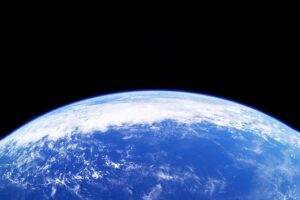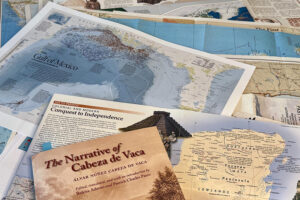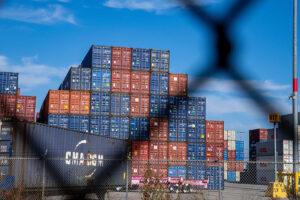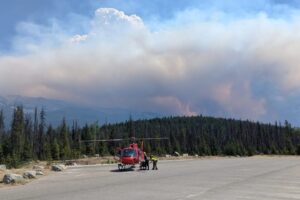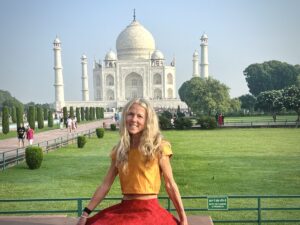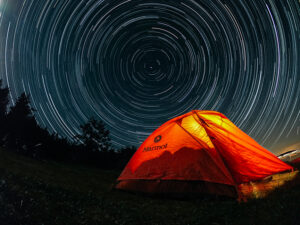Every few years, a new piece of technology revolutionizes outdoor image making. Not long ago, the GoPro and its offshoots gave us an indispensable tool for point-of-view action filming. A few years later, drones began to offer us the equivalent of our own private helicopter for aerial imagery. By 2010, the first high quality consumer drones were released, controlled from our smart phones through Wi-Fi.
A decade later, drones are everywhere. In the adventure space, they serve in mountain rescue, route exploration and just about any commercial purpose you can think of. The Bargiel brothers offered a fairly recent example of drone imaging doing something fresh. While Andrzej certainly had the trickier job, a first ski descent of K2, his brother Bartek piloted a drone from K2’s 5,000m Base Camp to over 8,000m in subzero temperatures. Technical issues or pilot error would have resulted in a lost drone and lost footage. I doubt Andrzej would have been keen to go back up for a second take.
Bartek was using the DJI Mavic Pro I. His success is quite the sales pitch for that model, but there are many other options out there. So which drones are best for adventure filming and photography? For serious work, the entry cost begins around $1,000. Let’s dive in, starting with the original Mavic Pro.
DJI Mavic Pro

Bartek Bargiel and his DJI Mavic Pro in the Karakorum. Photo: Bartek Bargiel
The Mavic Pro redefined drone photography in 2016. At the time, it was arguably the best commercial drone ever. Its features are tailor-made for adventurous souls: It is lightweight, foldable and surprisingly hardy.
This compact drone fits comfortably into a backpack. Even now, four years after its release, it remains top-of-the-range in terms of reliability and convenience. Drones are now smaller than ever, but few offer a comparable power-to-size ratio.
However, those four years have dated some features. For still photography, the camera pales in comparison to newer models, and the camera sensor is outdated.
It also lags behind in terms of obstacle avoidance. Newer models offer 360o sensors and improved AI functions. Its app also comes in for criticism, with users experiencing video stream freezes, which can make piloting tricky and a clear line of sight essential.
Canadian photographer Scott Forsyth (who has just won the Mountain Image prize at Banff Mountain Film Festival) also reports that the Mavic Pro had a “horrible time” in the Arctic, regularly losing signal and struggling to deal with the magnetic inconsistencies. Over the ocean, he needed to remain close to the water to ensure a strong signal. Flying too high risked an expensive watery death. It remained usable but required cautious flying.
For video, it has aged more gracefully. The 4k, 30fps video remains solid in 2020, and the 3-axis gimbal gives fully stabilized shooting.
This original Pro has dropped in price but remains around $1,000.
Key Stats
Flight Time: 27 minutes (though realistically lower in anything less than perfect conditions)
Weight: 743g
Dimensions: H83mm x W83mm x L198mm
Camera: 4k, 30fps, 3-axis gimbal, 12.71mp
DJI Mavic Pro 2

The Mavic Pro 2.
Released two years later, the Pro 2 offers substantial upgrades on the original and has become the model of choice for professional outdoor photographers.
Scott Forsyth upgraded from the Pro 1 to the Pro 2 primarily for the improvements to the camera. The sensor is much more advanced and allows him to shoot stills in RAW format. It also has a much higher pixel count (20mp vs 12mp). Another big advantage of the new camera is its ability to adjust the aperture from f/2.8 to f/11, even while airborne. This is particularly useful when recording video in changing light. The only drawback is that the Pro 2 has lost the ability to flip the camera and take verticals.
Scott Forsyth has also noted a marked improvement in Arctic performance. Signal loss is no longer a major issue, and there are fewer problems with video freezes. This improved performance is reflected in the operational temperature range, which starts 10oC lower than the original Pro, at -10oC.
Another professional Canadian videographer, Jassin Godard, specializes in drone work. He has also recently started using the Pro 2 alongside his Mavic Phantom 4 Pro V2. He has been impressed with the durability and stability, even in high winds. Since Godard is based in the Yukon, he needs a drone that’s capable in the cold. Largely, the Pro 2 has held up admirably.
Just once, working at -45oC, his whole kit froze, including the drone’s flight blades. Batteries also need to be protected. Godard carries a whopping 10 spare batteries and keeps them on his person for warmth. In extreme conditions, he uses warm water pouches to further protect the battery from freezing.
One interesting downside of the Pro 2, which prompted Bartek Bargiel to use the older Pro 1 on K2 instead, is that the inbuilt geofencing can be frustratingly limiting. Geofencing acts to automatically stop the drone from piloting into jet airspace or other off-limits areas. This functionality was a major barrier on K2, where the geofencing would block the drone from entering K2’s upper reaches. Bargiel found a workaround, but only by hacking the older model’s systems — something that was not possible on the Pro 2.
Overall, the design is very similar to the Pro 1, with almost identical dimensions and just a little more weight thanks to the improved camera. The price is far from identical, however, at around $1,700.
Key Stats
Flight Time: 31 minutes
Weight: 907g
Dimensions: H84mm x W91mm x L214mm
Camera: 4k, 30fps, 3-axis gimbal, 20mp
Autel EVO II

It’s not the prettiest drone but it sports a superb camera.
If you want something with still more camera chops, the Autel EVO II can film at up to 8k and boasts a 48mp camera.
It is a bit heftier than the Mavic Pro but is still foldable and built with durability in mind. Unfolded, it is significantly bigger but has a longer flight time as well as an improved camera. Autel is a less familiar brand than DJI, which has dominated the market since 2016, and the Autel EVO II is reportedly a bit rougher around the edges. The Autel Explorer app also lacks the polish of the DJI products.
Built for professional video use, it assumes that an operator has all the relevant licenses, so it lacks the geofencing restrictions mentioned previously. If Bargiel heads back for a crack at skiing Everest in winter, perhaps his brother should give the EVO II a shot.
The Autel EVO II is priced competitively, considering the camera equipment. You can pick one up for less than $1,500.
Key Stats
Flight Time: 40 minutes
Weight: 1150g
Dimensions: H110mm x W113mm x L228mm
Camera: Up to 8k, 60fps at 4k, 48mp
DJI Phantom 4 Pro V2

Jassin Godard’s other drone, the Phantom Pro, delivers better video and still photography than the two Mavic Pro models but greatly sacrifices portability. This drone would ideally be transported around in the back of a truck rather than a backpack. The bulky design, inability to fold up and long setup time make it more suitable for professional videographers or base camp setups rather than for outdoor athletes documenting their own expeditions.
This is a fast, powerful drone with improved object avoidance sensors and an excellent camera, particularly for video. One big improvement over the Mavic Pro 2 is the inclusion of an excellent controller. Using a controller eliminates the problems experienced with phones freezing or phone apps crashing unexpectedly. The downside is that it is another 904g to lug around.
The $1,600 price is almost the same as the Mavic Pro 2. Choosing between this and the two DJI models depends on whether the drone needs to be easily portable and how important the extra camera power (4k at 60fps) is to your project.
Key Stats
Flight Time: 30 minutes
Weight: 1375g drone, 904g controller, additional batteries 468g
Dimensions: 350mm diagonal (excluding propellers – not foldable)
Camera: 4k, 60fps, 20mp
DJI Mavic Mini

The early days of commercially available drones was akin to the Wild West. You could fly anywhere, anytime, with no permits. There were abuses: peeking through neighbors’ windows, hovering over sunbathing women, disturbing wildlife by flying too close. Countries scrambled to regulate the use of UAVs. One of the most common regulations is drone registration. In the U.S., Europe and China, any drone weighing over 250g must be registered. This regulation had an unintended side effect: Drone companies rushed out super-lightweight models to get under the cap. DJI produced the Mavic Mini, capable of landing in the palm of your hand.
It weighs 249g but the extreme miniaturization comes at a cost. The camera is understandably weaker than in the larger models. It can film at 2.7k and takes 12mp stills. The software has also been streamlined and is clearly intended for a more casual crowd.
A Mini runs about $470, making it substantially cheaper than professional drones.
Key Stats
Flight Time: 30 minutes
Weight: 249g
Dimensions: H57mm x W82mm x L140mm (folded)
Camera: 2.7k, 30fps, 12mp
PowerVision PowerEgg x Wizard

A odd-looking drone with unique waterproofing.
All of the drones listed so far suffer from a common problem: They don’t like water. Jassin Godard has successfully piloted his Mavic Pro 2 in light rain, but anything more is enough to ground a flight.
The awfully named PowerVision PowerEgg x Wizard offers a solution. It includes a waterproof casing and landing gear, taking the fear out of ocean filming. The company has been making underwater drones for some time, so the technology can be trusted.
The camera’s image sensor is quite small but can still record in 4k at up to 60fps. However, this is not a small model. It weighs at 862g and has similar bulk (and setup time) to the Phantom 4 Pro.
Cost around $1,200.
Key Stats
Flight Time: 30 minutes (without waterproofing options installed)
Weight: 862g
Dimensions: H102mm x W102mm x L178mm
Camera: 4k, 60fps, 12mp
General Information
Piloting drones is fairly consistent across models, and each generation streamlines the process, with better object avoidance and more AI options, such as the “home” function that automatically pilots the drone to a preset location if you lose signal or the battery drops below a safe level.
While piloting may be easier than ever, keeping up with drone regulations remains complex. Countries set their own rules regarding no-go zones, and some places such as Antarctica are completely off-limits — South Pole sledders and Antarctic peninsula cruise passengers, take note. Licenses are usually required for any commercial use, and you may have to seek permission to film in public locations.
Forsyth and Godard both mentioned that their drones are quite loud, making wildlife photography and filming tricky. Despite keeping an appropriate distance, Godard was shocked when a beluga whale off Ellesmere Island turned to look up at his drone. He backed off even further so as not to disturb the animal. In Africa, he describes taking precautions to avoid elephants, which interpret the buzzing of a drone to be bees and don’t take kindly to their presence!
